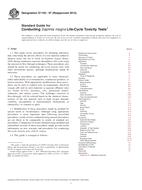Potřebujeme váš souhlas k využití jednotlivých dat, aby se vám mimo jiné mohly ukazovat informace týkající se vašich zájmů. Souhlas udělíte kliknutím na tlačítko „OK“.
ASTM E1562-00(2013)
Standard Guide for Conducting Acute, Chronic, and Life-Cycle Aquatic Toxicity Tests with Polychaetous Annelids
Automaticky přeložený název:
Standardní Průvodce pro dirigování akutní, chronická, a životního cyklu Aquatic zkoušky toxicity s Polychaetous Annelids
NORMA vydána dne 1.3.2013
Informace o normě:
Označení normy: ASTM E1562-00(2013)
Poznámka: NEPLATNÁ
Datum vydání normy: 1.3.2013
Kód zboží: NS-42199
Počet stran: 22
Přibližná hmotnost: 66 g (0.15 liber)
Země: Americká technická norma
Kategorie: Technické normy ASTM
Kategorie - podobné normy:
Anotace textu normy ASTM E1562-00(2013) :
Keywords:
acute toxicity tests, aquatic tests, Capitella capitata, chronic toxicity tests, Dinophilus gyrociliatus, estuarine environments, experimental design, exposure tests, LC50 tests, life-cycle toxicity tests, marine environments, Neanthes arenaceodentata, Ophryotrocha diadema, polychaetes, reproductive tests, saline water, static tests, toxicity, toxicology, ICS Number Code 07.100.20 (Microbiology of water)
Doplňující informace
| Significance and Use | |||||||||||||||||||||||||||||||||||||||||||||||||||||||||||||||||||||||||||||||||||||||||||||||||||||||||||||||||
|
5.1 Polychaetes are an important component of the benthic community, in which they generally comprise 30 to 50 % of the macroinvertebrate population. They are preyed upon by many species of fish, birds, and larger invertebrate species. Larger polychaetes feed on small invertebrates, larval stages of invertebrates, and algae. Polychaetes are especially sensitive to inorganic toxicants and, to a lesser extent, to organic toxicants (1).3 The ecological importance of polychaetes and their wide geographical distribution, ability to be cultured in the laboratory, and sensitivity to contaminants make them appropriate acute and chronic toxicity test organisms. Their short life cycle enables the investigator to measure the effect of contaminants on reproduction. 5.2 An acute toxicity or chronic text is conducted to obtain information concerning the immediate effects of an exposure to a test material on a test organism under specified experimental conditions. An acute toxicity test provides data on the short-term effects, which are useful for comparisons to other species but do not provide information on delayed effects. Chronic toxicity tests provide data on long-term effects. 5.3 A life-cycle toxicity test is conducted to determine the effects of the test material on survival, growth, and reproduction of the test species. Additional sublethal endpoints (for example, biochemical, physiological, and histopathological) may be used to determine the health of the species under field conditions. 5.4 The results of acute, chronic, and life-cycle toxicity tests can be used to predict effects likely to occur on marine organisms under field conditions. 5.5 The results of acute, chronic, or life-cycle toxicity tests might be used to compare the sensitivities of different species and the toxicities of different test materials, as well as to study the effects of various environmental factors on the results of such tests. 5.6 The results of acute, chronic, or life-cycle toxicity tests might be an important consideration when assessing the hazards of materials to marine organisms (see Guide E1023) or when deriving water quality criteria for aquatic organisms 5.7 The results of acute, chronic, or life-cycle toxicity tests might be useful for studying the biological availability of, and structure activity relationships between, test materials. 5.8 The results of acute, chronic, and life-cycle toxicity tests will depend partly on the temperature, quality of food, condition of test organisms, test procedures, and other factors. |
|||||||||||||||||||||||||||||||||||||||||||||||||||||||||||||||||||||||||||||||||||||||||||||||||||||||||||||||||
| 1. Scope | |||||||||||||||||||||||||||||||||||||||||||||||||||||||||||||||||||||||||||||||||||||||||||||||||||||||||||||||||
|
1.1 This guide covers procedures for obtaining data concerning the adverse effects of a test material added to marine and estuarine waters on certain species of polychaetes during short- or long-term continuous exposure. The polychaete species used in these tests are taken from laboratory cultures and exposed to varying concentrations of a toxicant in static conditions. These procedures may be useful for conducting toxicity tests with other species of polychaetes, although modifications might be necessary. 1.2 Modifications of these procedures might be justified by special needs or circumstances. Although using appropriate procedures is more important than following prescribed procedures, the results of tests conducted using unusual procedures are not likely to be comparable to those of many other tests. Comparisons of results obtained using modified and unmodified versions of these procedures might provide useful information concerning new concepts and procedures for conducting acute, chronic, or life-cycle tests with other species of polychaetes. 1.3 These procedures are applicable to most chemicals, either individually or in formulations, commercial products, and known or unknown mixtures. With appropriate modifications, these procedures can be used to conduct these tests on factors such as temperature, salinity, and dissolved oxygen. These procedures can also be used to assess the toxicity of potentially toxic discharges such as municipal wastes, oil drilling fluids, produced water from oil well production, and other types of industrial wastes. An LC50 (medial lethal concentration) is calculated from the data generated in each acute and chronic toxicity test. Reproductive success and the number of offspring produced are used to measure the effect of a toxicant on life-cycle tests; data are analyzed statistically to indicate that concentration at which a significant difference occurs between the test solutions and control(s). 1.4 The results of acute or chronic toxicity tests with toxicants added experimentally to salt water should usually be reported in terms of an LC50. The results of life-cycle toxicity tests with toxicants added experimentally to salt water should be reported as that concentration at which a statistically significant difference in the number of offspring is produced with reference to the control(s). 1.5 This guide is arranged as follows:
|
Podobné normy:
Historická
15.8.2014
Historická
1.6.2012
Historická
1.4.2009
Historická
1.10.2007
Historická
1.12.2012
Historická
1.12.2012
Doporučujeme:
Aktualizace technických norem
Chcete mít jistotu, že používáte pouze platné technické normy?
Nabízíme Vám řešení, které Vám zajistí měsíční přehled o aktuálnosti norem, které používáte.
Chcete vědět více informací? Podívejte se na tuto stránku.



 ASTM D5392-14
ASTM D5392-14 ASTM D5465-93(2012)..
ASTM D5465-93(2012).. ASTM D6734-01(2009)..
ASTM D6734-01(2009).. ASTM E1023-84(2007)..
ASTM E1023-84(2007).. ASTM E1193-97(2012)..
ASTM E1193-97(2012).. ASTM E1218-04(2012)..
ASTM E1218-04(2012)..
 Cookies
Cookies
